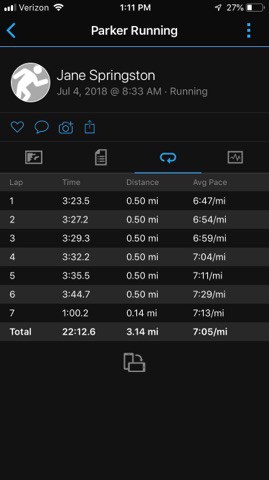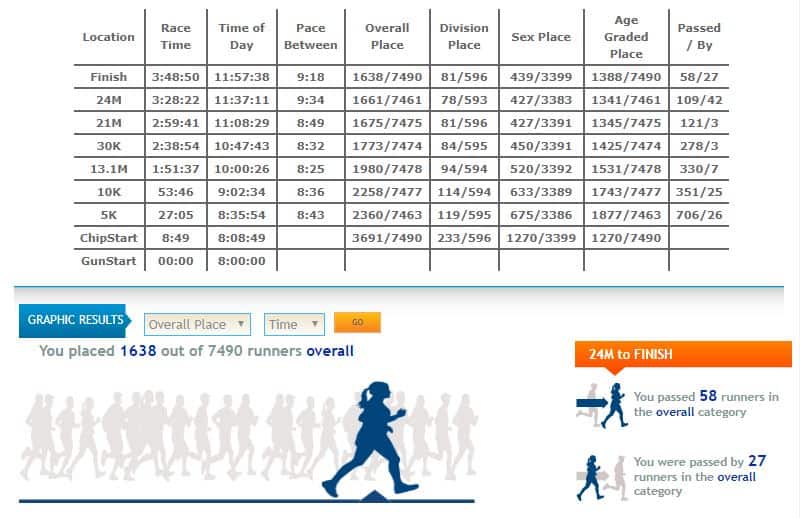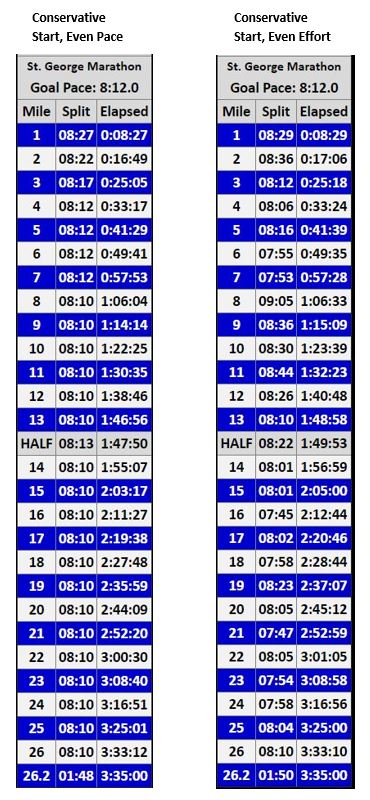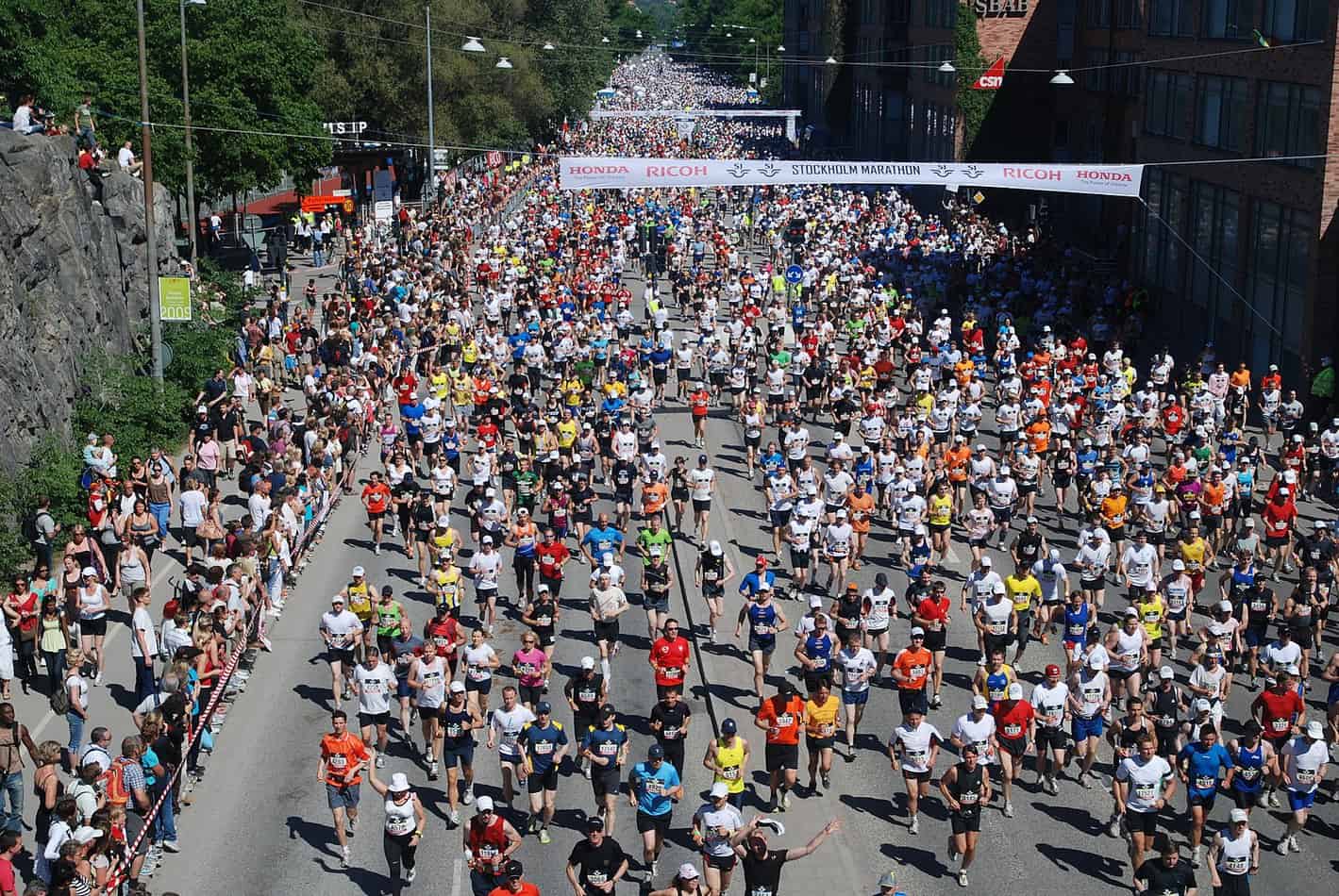Whether you’ve run a marathon before or not, you’re likely not new to the racing part of running. The feelings that come up as you await the starting gun are similar for every running distance. Maybe you’re two parts excited, one part nervous (or the other way around)…and you have energy you’re ready to burn. Seconds later the gun goes off and the adrenaline is coursing through your veins. Your watch beeps at mile one and you realize you’re going too fast. Decide to slow down and you risk a slower time…keep the speed to bank time and end up with a faster time. Or wait…is that how it works?
I’ve been here many times before, so I really wanted to know. Is banking time in a marathon a good or bad race strategy? Banking time in your marathon means you run the first several miles of your marathon faster than your goal pace. Instead of saving your energy for later, you burn more energy early on to get on track for a faster marathon time. In theory, this sounds like a valid strategy. The truth is that it’s one of the quickest ways to sabotage your marathon.
Here’s why going out too fast won’t work out in your favor and what to do instead.
What does the term “bank time” mean?
In terms of racing, if you are banking time this essentially means that you are going faster at the beginning of your race. Whether you are utilizing this strategy on purpose, or you just find you can’t slow yourself down in those early miles, you are banking time. It’s the same concept as putting money in the bank for a rainy day emergency. Someone’s goal of putting time “in the bank” is time you can save up for later. In a race it might go like this in your head:
If I go faster now, I can bank time. That way if I hit a wall at mile 20, I’ll be ahead of where I need to be. I’m sure I’ll have to slow down, but I’ll have that extra time saved up.
Except if you bank time, the chances are high that it won’t be “if” you hit a wall, but “when.” And it might come long before mile 20. Though your marathon may start out fun and exciting, the grueling finish will leave you wondering where it all went wrong.

Photo Credit: Fabian Diercks from Pixabay
Why Banking Time Might Sound Like a Good Strategy
Many years ago, my dad and I ran a 10k together. We had trained to run around an 8:30 pace. So when we crossed mile 1 and our watches said 7:50, my dad said, “We’re going too fast!” I probably responded with something like “it’s fine” and we kept right on trucking. I was actually excited we were going that fast because I felt so good. This is exactly where the problem starts.
You may not go into your race planning to bank time. But as you see those fast miles tick by, your adrenaline takes over and you lose some mental control over your plan. You might think:
- Everyone else around me is running fast, so I should be, too.
- You’ll be able to run all of the miles at that pace and set a huge PR.
- Or at least if you can’t maintain that pace you hopefully won’t slow down too much and still get a PR.
People can’t be faulted for thinking this is a good strategy. You probably don’t even realize your wheels are falling off at the end of your race because you’re went out too fast. It seems counterintuitive to practice prudence in a race when you’re supposed to be going for your best time. But if you don’t, it will cost you.
My Experience With Banking Time
I know a lot about this “strategy” because I ran this way for years. I stayed happy with my times overall, but ultimately I plateaued in my running ability. It wasn’t until I learned to take the beginning slower and build speed that I actually started breaking barriers in my running.
Though this was just a 5k race, this is a perfect example of what “banking time” in a race can look like. Other than the home stretch, I got slower every single half mile. I remember feeling amazing at the beginning and feeling like I was going to die at the end. Not good.

Consequences of Banking Time
It’s not easy to hold yourself back in a race. I have been racing for a very long time, I KNOW I need to be conservative, yet I still struggle with it. I would say the latter half of my training last year is when I really realized the consequences of banking time (and the benefit of doing the opposite). It takes some serious discipline.
These are some consequences of banking time (even by going just 10-15 seconds per mile faster than your goal pace) in a marathon.
Your legs become fatigued early on.
Since you’re running at a faster pace than you have trained for, you’re using different muscles than you are used to. Yes, you probably included speedwork in your training, but that was probably on a run of 10 miles or less. When you use those fast-twitch muscles, or your stride is different than what it would be at your goal pace, you’re risking early fatigue in your leg muscles and joints. You don’t get to stop at 10 this time and that makes a big difference.
You run out of energy.
It’s just not possible to maintain your half-marathon pace (or faster) for a marathon. Even elite runners can’t do that. There is a maximum pace your body can go for a certain distance. The last thing you want is to feel like you’re running out of breath way too early in your race. Even though those first few miles might feel amazing at that pace, sooner or later, your energy will fade. That feeling is when you’ve put your aerobic system in overdrive and you start tapping into your anaerobic system – you can find a great explanation here. Doing so is going to cause your pace to tank quickly.
You hit the inevitable “wall” way too early.
First of all, it IS possible to avoid hitting the wall in a marathon. But for most runners, it is very common. Even the best-trained athletes can feel the effects of pushing through those last miles at race pace and have to dig deep to hold onto it. But the goal is to keep that wall from showing up, or at least keep it at bay as long as possible. Banking time is only going to bring that wall to you much, much sooner. Maybe it happens at mile 16 or maybe mile 20…but that’s still a long way to go.
You may have to walk.
There is nothing wrong with walking in a marathon if that’s your plan. But if your goal is to run an entire marathon and you go in undertrained or you don’t race smart, that’s on you. (I’ve been there more than once and I own that.) If you go out too fast in a marathon, you’ll basically run yourself into the ground. Needing to walk is a very likely outcome.
People start passing you.
This part just might be the worst. Being completely drained and exhausted might not be so awful if you could commiserate with everyone else around you as you all drag yourselves to the finish line. Except then you realize there were people who raced much smarter and went out slower than you. The people who didn’t bank time suddenly start passing you in those later miles. It feels a lot better being the passer instead of the one getting passed.
This chart from my Twin Cities Marathon shows how many people I passed in the race and how many people passed me. I didn’t do too badly, but there were 27 people who had a better-executed marathon than I did.

You get a DNF
DNF stands for Did Not Finish – you can read a lot more about that here. After months of hard work and training, it’s the last thing you want next to your name on the marathon race results page. Obviously this is a worst-case scenario, but it can happen when you make the decision to bank time. All the fatigue and lack of energy you’ll feel later on could cause you to be unable to get to the finish line.
The article, “Slow Starts, Fast Finishes” has an incredible amount of data to prove that going out too fast is poor race strategy.
A Better Race Strategy – Even Pacing with a Conservative Start
So if banking time is poor race planning, then what should you do?
Your best bet is to run an evenly paced race but holding back and going a little slower than your goal race pace those first several miles. It might make you feel anxious to see a pace on your watch slower than what you’ve trained for or to be going slower than everyone else around you in the beginning. But you have to remember that 26.2 miles is a long way. You have plenty of time to make it up, and your legs will thank you later. With the right training and a realistic goal pace, you actually can arrive at those late miles with more left in the tank.
And what a great feeling it would be to arrive at mile 20 ready to fly. (And then you get to be the one passing everyone else!)
These are marathon pace bands from findmymarathon.com. (Head there to get these for your next race!) My goal time is 3:35 for this race which is equal to an 8:12 mile. The first band shows a conservative start with an even pace the rest of the race. The second band shows a conservative start using an “even effort” pacing strategy. This takes into account elevation – essentially going slower on the hills, and faster on the downhills.

Which is better? I think these are both great strategies, though I would probably hold back longer than a couple of miles “conservative start, even pace.” I will definitely be starting conservatively but utilizing the more “even effort” approach. The hardest part about this is knowing you’re slowing down on those hills. Seeing your pace drop on those portions of the course can be tough to swallow, but you have to remind yourself that you’re actually conserving energy for the flatter and downhill portions.
Thinking of running negative splits? If you can do this, certainly more power to you!! This means you’ll run the second half of your marathon faster than your first half. I actually did this in my Revel race last year, but that’s because the first 5 miles had close to 600 feet of elevation gain. Depending on your course, it’s actually not always the best strategy.
PRO Tip: Start slower than your marathon goal pace. Then focus on an even effort strategy for the rest of your marathon staying close to your marathon goal pace. Then give it all you’ve got those last couple of miles!

Photo Credit by Dean Moriarty from Pixabay
Getting It Right the Next Time
It’s important to remember that slowing down some at the end of the marathon is normal. If you find yourself struggling to hold the pace those last few miles, you are far from alone. You may have gone out a little too fast, but there could be a host of other reasons for this as well – nutrition, hydration, poor weather, running too fast up hills, etc. As well as the fact that running a marathon is not a normal feat to push your body to do. It’s hard!
I’ve outlined why banking time in a marathon is a bad idea, but finding the proper pace for you takes experience and practice over time. If you’ve experienced a major slow down from banking time, you should still be VERY proud of your accomplishment. Next time, you’ll be one step closer to racing a better marathon.
Haven’t started training and not even sure what your marathon goal race pace should be? Mcmillan Running’s Race Time Predictor is an excellent place to start.







